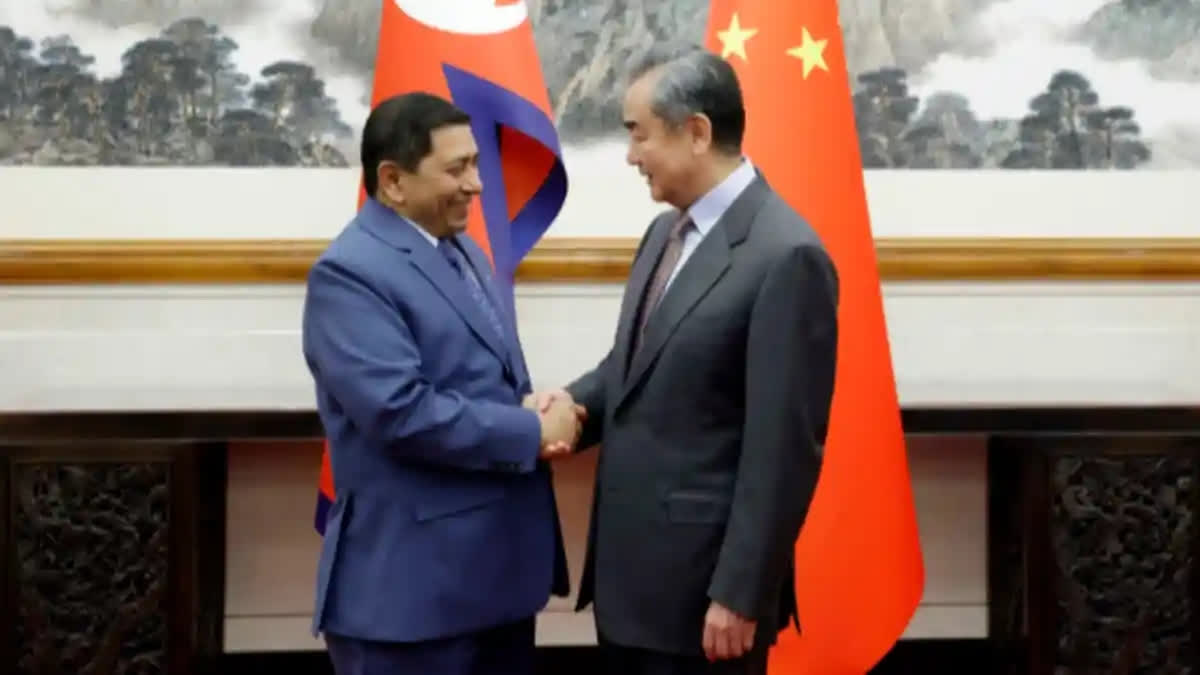New Delhi: Though Nepal has proposed to China the construction of an economic corridor passing through Chinese provinces, the whole issue of feasibility comes into play here. Returning to Nepal after a nine-day-long official visit to China, Nepal Deputy Prime Minister and Foreign Minister Narayan Kaji Shrestha told reporters in Kathmandu that he had very positive discussions with Chinese officials regarding the construction of an economic corridor.
“We had very positive discussions on developing economic and development corridors between Nepal and China,” Shrestha was quoted as saying by the Kathmandu Post. “The focus of my visit was economic diplomacy. Nepal has been thinking about this new concept (the idea of corridors) after China introduced the Trans Himalayan Multi-Dimensional Connectivity Network (THMDCN), which comprises economic and connectivity corridors to be developed under the Belt and Road Initiative.”
The proposed corridor will start from the Nepal-Tibet border, pass through Sichuan and end in Chongqing province. It may be mentioned that the Chinese provinces of Tibet, Sichuan and Chongqing have been entrusted with the responsibility of engaging, promoting and expanding relations with Nepal under China’s periphery diplomacy policy.
So, what is Beijing’s periphery diplomacy policy?
China’s periphery diplomacy refers to the foreign policy approach and strategies adopted by China concerning its neighbouring countries and regions. The primary objective of China's periphery diplomacy is to maintain stability, security and influence in its surrounding areas as well as to promote economic cooperation and regional integration.
According to Jacob Stokes, a senior policy analyst in the China programme within the Asia Centre at the United States Institute of Peace, though China is expanding its influence around the world, the heart of its diplomatic efforts still lies in its complex neighbourhood.
“To advance the country’s interests in the region, Chinese leaders practice an interlocking set of foreign affairs activities they group under the umbrella of ‘periphery diplomacy’,” Stokes wrote in a special report on China’s periphery diplomacy in May 2020. “China’s strategic rationales for working more closely with its neighbours include upholding the security of its border, expanding trade and investment networks, and preventing a geopolitical balancing coalition.”
Stokes further wrote that Beijing uses a range of tools for periphery diplomacy, including deepening economic integration, engaging neighbouring major powers and at times using coercion to achieve its aims. “Although states around China’s periphery welcome trade and investment ties with Beijing, China’s more assertive actions in recent years have engendered fear and wariness about Chinese intentions,” he stated.
Now, what is the Trans Himalayan Multi-Dimensional Connectivity Network?
In 2022, China and Nepal agreed to build the so-called THMDCN following a meeting between the Foreign Ministers of the two countries. The agreement outlines that China will fund a feasibility study for a cross-border railway connecting China and Nepal. Chinese experts will visit Nepal to conduct surveys and assessments for the proposed project. This railway is part of Chinese President Xi Jinping’s pet Belt and Road Initiative (BRI). Under this initiative, infrastructure such as railways and communication networks will be constructed to enhance connectivity across the Himalayan region.
It will serve as an economic corridor between Nepal and China, under the BRI. The construction of this network was appreciated by Chinese President Xi as switching Nepal “from a landlocked to a land-linked country”. It is worth mentioning here that during delegation-level talks between Shrestha and his Chinese counterpart Wang Yi in Beijing last month, both sides again decided to implement the BRI in the Himalayan nation.
A Nepali participant in the meeting was quoted as saying that both sides agreed to sign the implementation plan “as soon as possible”. Though no specific date has been finalised, “it could happen during an upcoming foreign secretary-level meeting in Kathmandu or on the seventh anniversary of the signing of the BRI on May 12, or during any other high-level visit between Nepal and China”, according to the participant.
Though Nepal and China signed the BRI framework agreement on May 12, 2017, and China forwarded the text of a plan in 2019, no further progress has been made mainly due to Kathmandu’s concerns over debt liabilities. Nepal has made it clear to China that it is not interested in taking commercial loans for implementing BRI projects.
The BRI is a global infrastructure development strategy adopted by the Chinese government in 2013 to invest in over 150 countries and international organisations. It is considered a centrepiece of President Xi’s foreign policy. It forms a central component of Xi’s “Major Country Diplomacy”, which calls for China to assume a greater leadership role in global affairs in accordance with its rising power and status.
Observers and sceptics, mainly from non-participant countries, including the US, interpret it as a plan for a Sino-centric international trade network. Critics also blame China for putting countries participating in the BRI under debt traps. In fact, last year, Italy became the first G7 country to pull out of the BRI. Sri Lanka, which participated in the BRI, eventually had to lease out the Hambantota port to China due to debt repayment issues.
India has opposed the BRI right from the beginning, mainly because its flagship project, the China-Pakistan Economic Corridor (CPEC), passes through Pakistan-occupied Kashmir.
So, is a China-Nepal economic corridor feasible?
“The main problem is everything will be very expensive,” an expert on China told ETV Bharat on the condition of anonymity. “Nepal does not have the wherewithal to pay back Chinese loans,” the expert said. “India gives grants to Nepal to implement infrastructure projects. China does not give grants. The proposed corridor will have to be built on a very large scale.”
Another problem that will arise is, according to the expert, finding a market to sell the goods manufactured in the proposed economic corridor. The Nepal market is very small, The goods manufactured in China cannot be sold back to China. “The most viable option is the Indian market which is huge,” the expert explained. “China wants access to the Indian market. For this, it is using Nepal. India will not open up its market to be flooded with Chinese-manufactured goods. Even if it does, there will have to be some quid pro quo.” According to the expert, the other option the two countries can possibly explore is selling these goods in third countries in Central Asia using China as a transit corridor.
- " class="align-text-top noRightClick twitterSection" data="">
Read more: Nepal, China Renew BRI Implementation Plan: Should India Be Concerned?



